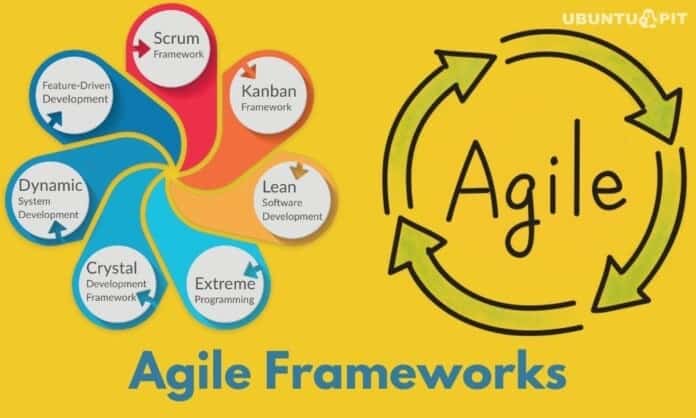Agile software development is a methodology related to application development focusing on an iterative process, where cross-functional teams collaborate to produce better solutions. Agile frameworks are unique methods or techniques in the development process following Agile principles. Most companies use these frameworks to mitigate their particular needs. Many popular Agile frameworks are available in the market. Different businesses utilize them according to their specific needs. It is significant for the product’s success to embrace a solid framework that aligns with the team’s requirements. That’s where we come in. Today we will help you to choose an Agile framework that matches your team requirements.
Best Agile Frameworks
If your team follows the Agile methodologies, you should go for any suitable framework. The framework will offer you tools and techniques that make the whole process convenient. Therefore, we have listed the best 10 Agile frameworks vital for software development.
01. Kanban
Kanban is a famous project management framework. Forty-three out of a hundred companies use Kanban to handle their projects. The framework is a basic but successful approach to software creation. Kanban concentrates on workflow visualization and signifies work in progress (WIP), allowing it to efficiently adapt it to the team’s capacity.
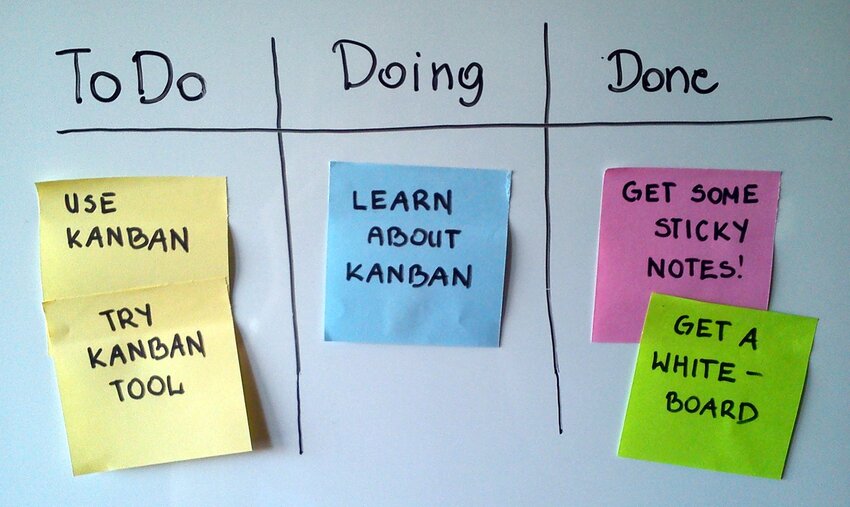
When a job is finished, the team will move on to the following file in the pipeline. As a result, the implementation process allows for more planning flexibility, quicker delivery, consistent priorities, and accountability. Kanban has no standard approaches within the method, as well as fixed repetitions like other frameworks. A bug, how small may it be, is fixed by the framework right away. The framework even works fine after the release of the developed product.
Key Features
- Kanban visualizes the workflow using Kanban Board. Whiteboards or sticky notes generally represent the board.
- There is a card for each work in Kanban. So, every team member can see who is accountable for what work and when he is supposed to complete his work.
- To ease communication between team members, they can attach screenshots or documents, leave comments or provide links.
- The teams using Kanban can trace colleague’s works and assist them in finding problems.
- Reducing the number of tasks in the workflow is one of the main attributes of so many companies.
02. Scrum
Till the release in the 1990s, Scrum is still a widely used Agile framework. Scrum takes an iterative project management approach, similar to other Agile models. The Scrum technique suggests dividing a project into sprints where each sprint typically takes one to four weeks. The sprints conclude with the execution of a feasible version or draft of the project’s final product. Moreover, the framework has short iterations that allow your team to deliver a working version of the ultimate result endlessly.
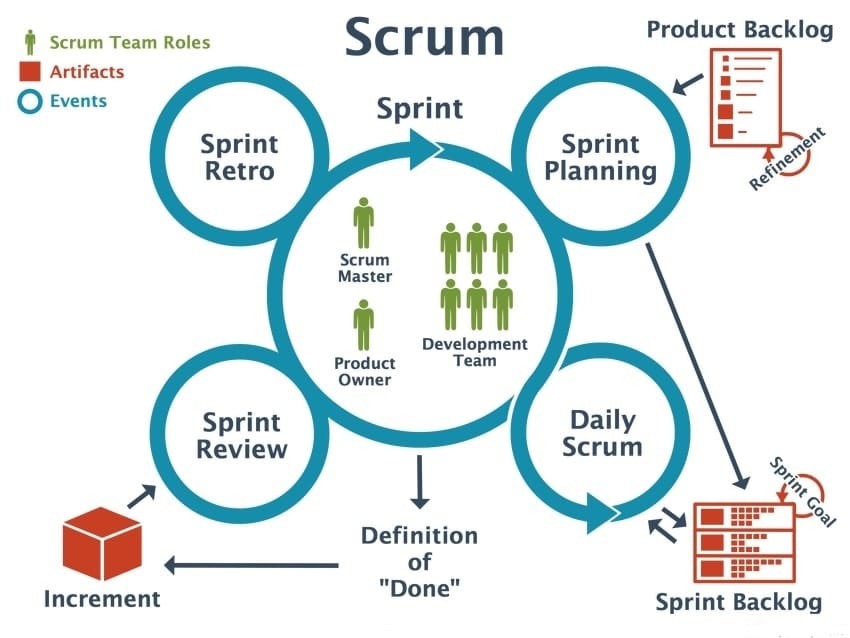
Scrum was originally developed using a software model that adheres to meetings, obligations, and roles. It’s so versatile that you can use it on any massive project in any field, but it’s most effective when it produces a tangible product rather than a service. Scrum actually works in all environments and is lightweight. However, mastering Scrum is a little tricky.
Key Features
- The framework utilizes several Agile engineering methods ensuring maximum productivity out of the development team.
- The sprint is an exclusive feature of Scrum. Every sprint has a definite deadline which motivates the team to complete their tasks in time.
- Transparency, one of the three pillars of the framework, enables everyone to follow the project and give their necessary thoughts.
- The Scrum method centers highly on the product’s quality which results in lesser mistakes.
03. Extreme Programming
Extreme programming (XP) is an Agile methodology that was created specifically for software development projects. This framework, like Scrum, centers on client delivery, continuous development and employs intervals or sprints. The framework was initially developed to tackle the high cost of new conditions and develop good innovation practices to boost software performance.
XP is an Agile approach that focuses on applying the best software practices and is focused on application development. Furthermore, it stresses the same principles that are expressed in Scrum and the Agile Manifesto. It was XP that introduced many groundbreaking regulations to software development that are now common. Features like iterations, test-driven development, and continuous integration were all XP’s ideas.
Key Features
- Test-Driven Development (TDD) is an innovative engineering methodology that accelerates the software design process using automated unit tests. It has a test-first approach different than other frameworks.
- XP does the tests in such a way that the mistakes in the code are easily captured. Besides, every software component receives feedback which ultimately increases the final product quality.
- Continuous Integration enables developers to contribute new codes to the project multiple times a day.
- XP has a feature called Pair Programming. Here two programmers work together. One of them writes code while the other observes, thus increasing the overall efficiency.
04. Lean
Lean Development is a software development approach derived directly from Toyota’s Lean Manufacturing methodology. The Agile framework provides a conceptual structure and adheres to standards, principles, and best development practices implemented in Agile development. According to the most recent figures, 17% of businesses have adopted Lean.
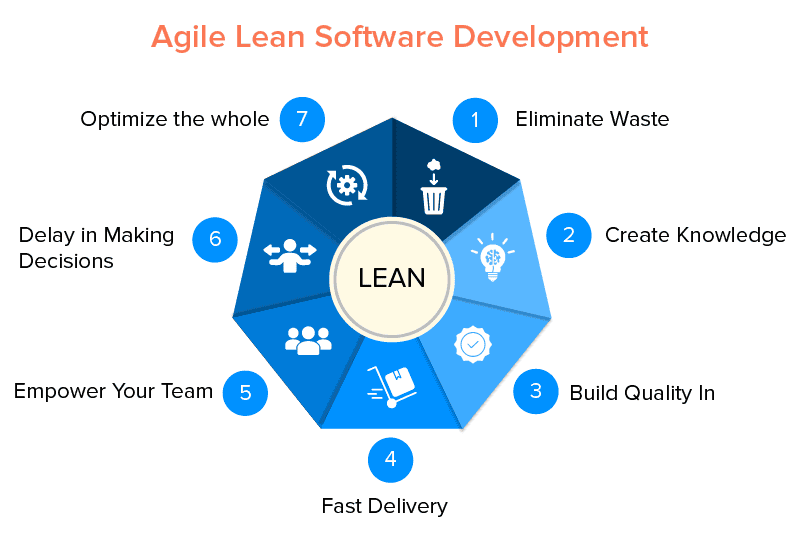
The software development process has seven basic principles. They are getting rid of waste, empowering the team, delivering as fast as possible, building quality, deciding as late as possible, and enhancing learning and knowledge. These principles make Lean what it is. You can get the maximum out of any project by utilizing the principles. All these make Lean one of the developer’s first choices.
Key Features
- According to the basic principles, Lean anything unnecessary as waste. It gets rid of the waste in every way possible.
- It enhances the learning process by integration testing, short iteration cycles, and refactoring. Besides, customer feedback gives opportunities to trace problems.
- Short iterations of small batches of Lean generate useful feedback and help in quick decision-making.
- Lean emphasizes the team as a center of decision-making, and management looks to the team for the best solutions and costs.
- Ensure that consistency is built into the system by automating testing through builds, installations, and continuous integration.
05. Dynamic Systems Development Method
The Dynamic Systems Development Method (DSDM) was born out of the requirement for a standardized industry structure for rapid software development. Rework is required under DSDM, and any implementation modifications must be reversible. The DSDM system, like Scrum and XP, divides tasks into smaller sprints. Atern is the most recent edition of the framework.
DSDM is one of the oldest Agile processes, and it encompasses the whole project lifecycle. This approach is very comprehensive, and it ensures that the project does adequate design work before beginning any development. Moreover, The DSDM paradigm is an iterative methodology to software development that states that every project must be matched to clearly established strategic priorities and concentrate on early delivery of tangible business benefits.
Key Features
- To assess the conditions to be included in a release or iteration, DSDM employs a prioritization strategy known as MoSCoW, which refers to Must, Should, Could, and Won’t.
- By varying the features, the Atern methodology repairs the program, expense, and performance while obtaining contingency. This implies that the Minimum Usable Subset (MUS) of features is delivered.
- DSDM incorporates the appropriate stakeholders at the appropriate times throughout the project and guarantees that team members have the authority to make decisions.
- Constant re-evaluation and testing early and simultaneously maintain the product quality. The framework regularly observes test-driven developments for making a comparison.
06. Crystal
Crystal refers to Agile methodologies such as Crystal Orange, Crystal Clear, Crystal Red, Crystal Yellow, and many more. Each crystal approach has its own structure, and the number of factors, including the size of your team, project goals, and project robustness, determines which one to use.
When determining how to implement Agile, it’s essential to keep in mind that different projects necessitate slightly different strategies, procedures, and methods based on their specific characteristics. It would be best if you chose a definite Crystal methodology based on the facts. Again, Alistair Cockburn’s Crystal Methodologies are intended for projects sizing from individual teams producing simple solutions to big teams finding complicated solutions.
Key Features
- One of the safe Agile framework’s main attractions is that the teams may find opportunities to grow and refine their work processes independently.
- Allows teams to operate in whatever manner they see fit.
- Allows for direct group interaction, transparency, and governance.
- Teams can react quickly to changing conditions. Thanks to the adaptive approach.
- Since programmers built it around project members and are not based on any specific number of procedures or resources, the Crystal approach is one of the most flexible Agile frameworks.
07. Feature Driven Development
Another software-specific Agile paradigm is Feature-driven development. FDD seeks to generate software models every two weeks. Moreover, it involves a distinct design and development plan for each software model attribute, making it more documentation-intensive than other Agile frameworks. Teams with specialized design and planning skills suit FDD due to its stringent documentation requirements.
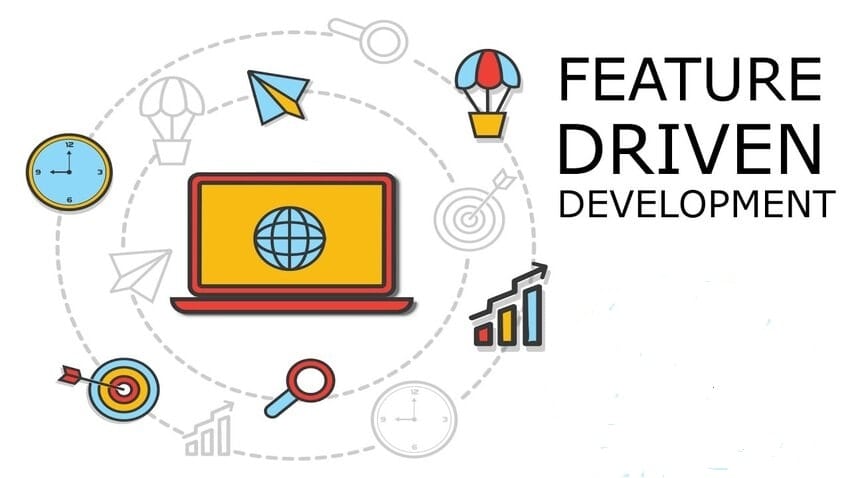
Also, FDD is a 1990s-era approach to software development that is iterative and gradual. Besides, its attributes are discrete chunks of client-valued functions. Developers divide domain models into content areas, which they present as business operations, using documentation. Using the FDD process, the developers will first create a product concept before making a list of features. Using an iterative and gradual approach, they would prepare a plan for how the product would be created.
Key Features
- It’s a five-step method framework. The methods keep the whole process disciplined as well as enable more fast development.
- The framework is applicable for both small and large teams. Not only small teams but also large teams can develop products with continuous success.
- Pre-defined development standards are available, which leverages the team to solve any problems quickly.
- FDD could be appropriate for your project if you work for a big company or are involved in a large-scale project as it employs the top-down decision-making approach.
- High dependency on senior engineers may sometimes make the process a little week. However, its other feature complements the whole thing.
08. Adaptive Software Development (ASD)
RAD practices have given rise to Adaptive Software Development. Its goal is to allow teams to efficiently and decisively adapt to changing demands or market needs by developing their products through versatile scheduling and continuous learning.
In the early 1990s, project managers John Highsmith and Sam Bayer developed the Adaptive Software Development methodology. They created ASD as a more recursive and shortened version of the agile methodology Rapid Application Development (RAD).
Adaptive Software Development methods allow for change and adaptability in a volatile environment, with products changing quickly and little preparation and learning. Like the Evolutionary model, ASD is gradual, with step names representing the uncertainty of complicated systems. The phases related to it are speculating, collaboration, and learn.
Key Features
- The step speculate has a significant role in team planning. It observes the system and finds out problems from any complex system.
- The whole process promotes innovation and discovery, allowing team members to add exclusive features to the software in production.
- Complex applications need a lot of data. The collaboration step enables the collection and analysis of information required for the project.
- ASD allows team members to work efficiently and jointly and gain knowledge and share their work.
- The learn part of the framework consistently delivers vital knowledge for project development to the members.
09. Scaled Agile Framework (SAFe)
SAFe is the world’s most common system for scaling Agile through organizations. Hundreds of the world’s largest companies use SAFe as it enables and accelerates faster time-to-market, significant improvements in efficiency and quality, and improved employee engagement. Moreover, the framework is a system for helping companies deliver value on a stable and accurate basis.
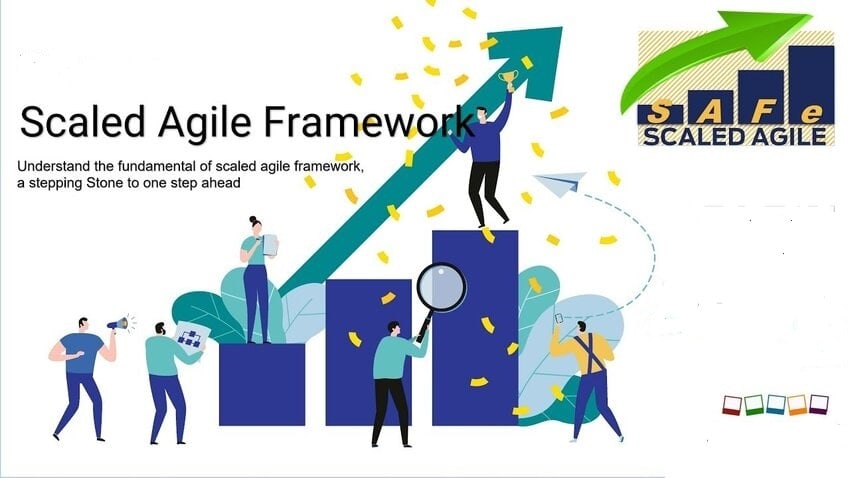
SAFe encourages large groups of agile teams to coordinate, collaborate, and deliver. Nevertheless, it has three basic bodies: lean product development, systems thinking, and agile software development. SAFe offers a consistent method for scaling agile as companies grow in size. SAFe has four settings to fit different scale sizes such as Portfolio SAFe, Essential SAFe, Full SAFe, and Large Solution SAFe.
Key Features
- The core values of SAFe explain the culture that leadership must promote and how people can act within that environment to use the system adequately.
- It focuses on planning at all levels of the company. As a result, everyone is aware of its present state, its objectives, and how team members can work together to obtain the objectives.
- All stages of the organization remain aligned by constantly coordinating people and activities.
- Unlike typical top-down management & control systems, information flows both upward and downward on time.
- SAFe promotes trust-building behaviors such as breaking down work into smaller batches so that developers can identify issues faster, offering real-time insight into backlog progress across stages, and inspecting and adapting routines.
10. Rapid Application Development (RAD)
Rapid application development (RAD) is a technique that emphasizes regular iterations and continuous feedback to create applications quickly. As a matter of fact, the IT industry is experiencing pressure to produce working products faster. The highly competitive software market emphasizes a greater demand for new software, and RAD is becoming a requirement.
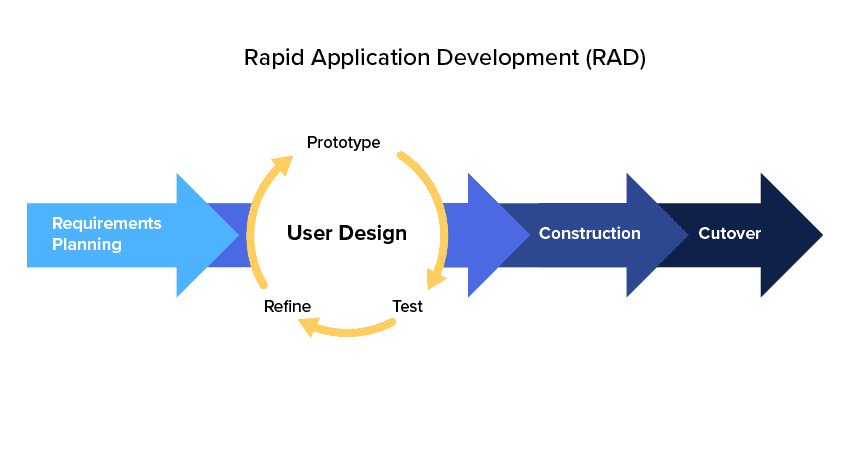
In 1991, technology expert and writer James Martin developed the RAD system, which recognized and exploited software’s endless malleability to create development models. Nevertheless, the framework was a forerunner of agile project management. It’s rising in popularity among agile companies looking for ways to keep up with their changing market and client needs.
Key Features
- Developers can make fast changes during the development process, giving them more versatility and adaptability.
- Encourages code reuse, which implies fewer manual coding, fewer bugs, and faster testing times.
- Improved customer contentment as a result of high-level communication and partnerships among stakeholders
- Enhanced risk management as investors can analyze and identify code weakness while development processes continue.
- RAD requires implementations early in the software development phase, unlike the Waterfall approach.
Last Words
Everyone wants to be successful in their career. However, success is not something you can find in the corner of the road. You have to work hard for that. You have to learn and enhance your knowledge. Make yourself skilled. Software development is not any different. To have a fruitful career in application development, you have to go through many things. The Agile framework is one of them.
You cannot think of any robust business without Agile. Thus, we have listed the best ten Agile frameworks you should look at if you want to go deep into software development. Hopefully, the article was beneficial to you. Nevertheless, we have listed only ten of them, whereas there are hundreds of them. Let us know if you think of any framework that should have been added to the list. Comment below if you want more articles like this.
